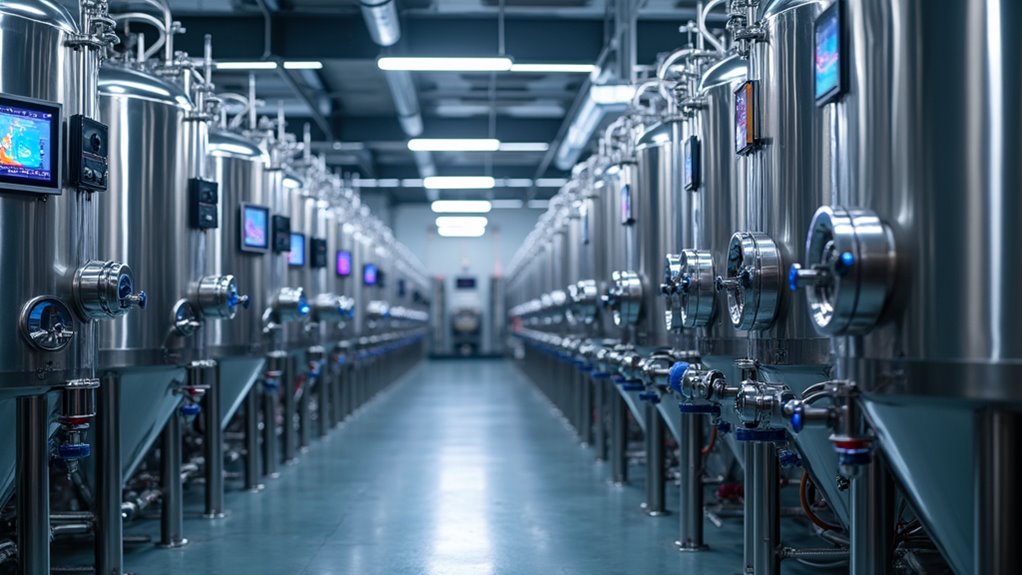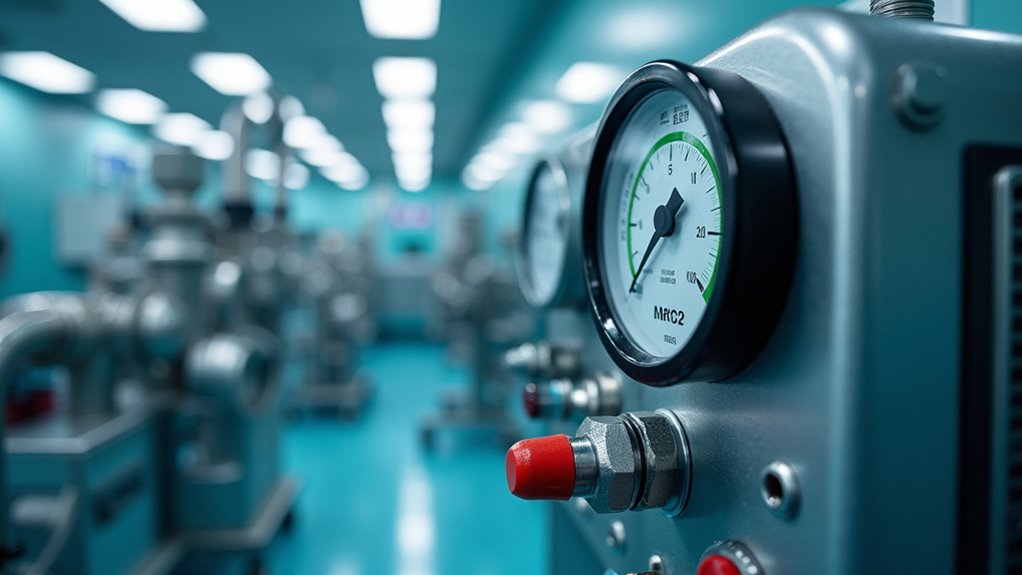You’ll find significant N₂O reductions through smart fertilizer management using the 4R framework, which cuts emissions by 40-50% in corn systems. Implement advanced industrial controls with N₂O pyrolysis catalysts for 80-90% efficiency. Deploy point-of-care gas management in healthcare to reduce emissions by 52%. Optimize wastewater treatment, adopt sustainable manure practices, and integrate biochar solutions. These proven strategies can help achieve the global target of 60% N₂O reduction by 2025, with each method offering unique advantages for different sectors.
Smart Fertilizer Management in Agriculture

Reducing agricultural nitrous oxide emissions hinges on the strategic implementation of smart fertilizer management practices. By adopting the 4R Nutrient Stewardship Framework, you’ll cut emissions by matching the right source, rate, time, and place of fertilizer application. These practices can reduce excess nitrogen availability by up to 50% while supporting bioreactor innovations in soil management. Nitrogen-containing fertilizer overuse significantly contributes to harmful emissions across US agriculture. Side-dressing manure during corn growth can substantially decrease emissions compared to pre-planting application.
You’ll achieve the best results by combining controlled-release fertilizers with nitrification inhibitors, which can decrease emissions by 40-50% in corn systems. The reduction process heavily depends on soil microorganisms that cycle nitrogen through various organic forms. Integration of precision agriculture technologies, including GPS-guided applications and real-time soil monitoring, enables carbon negative cropping through targeted nutrient delivery. When you pair these approaches with AI-powered predictive models, you’ll optimize fertilizer schedules and achieve emission reductions of 15-25% while maintaining crop yields.
Advanced Industrial Process Controls

While traditional emission controls focus on end-of-pipe solutions, advanced industrial process controls offer a thorough approach to N₂O reduction through integrated catalytic systems. You’ll achieve significant reductions by implementing primary controls with improved ammonia oxidation catalysts, yielding 30-85% decreased emissions in new plants. Operators must ensure compliance with Best Available Techniques to maintain their environmental certification status. Leading consultants like Krüger and Jacobs are driving innovation in process control optimization across wastewater treatment facilities.
| Control Type | Reduction | Integration |
|---|---|---|
| Primary | 30-85% | Fuel cell integration |
| Secondary | 80-90% | Variable speed control |
| Tertiary | 90-95% | Tail gas extraction |
| Hybrid | >95% | Combined systems |
Secondary controls using N₂O pyrolysis catalysts deliver 80-90% efficiency rates. By incorporating variable speed control and fuel cell integration into your existing systems, you’ll optimize both energy consumption and emissions reduction. With 90% of facilities currently using imported catalysts, upgrading to advanced process controls presents a clear path in meeting 2025 regulatory requirements.
Healthcare Facility N₂O Optimization

Implementing point-of-care gas management through portable N₂O cylinders at your healthcare facility can reduce emissions by up to 52%, as demonstrated by NYC Health + Hospitals’ successful shift from central piped systems.
As shown during the 2022 CleanMed Conference, leading healthcare facilities have successfully transformed their nitrous oxide delivery methods to reduce environmental impact. You’ll need to establish detailed leak prevention protocols, including real-time gas flow monitoring and systematic equipment checks, to optimize cylinder usage and minimize waste. Regular monitoring using environmental scorecards helps track performance against benchmarks.
A comprehensive DMAIC framework should guide your facility’s optimization efforts for maximum waste reduction. Your facility can track performance metrics through sustainability dashboards while ensuring compliance with ASA guidelines for portable tank operation and alternative anesthetic strategies.
Point-of-Care Gas Management
Modern healthcare facilities have revolutionized nitrous oxide management through point-of-care technology (POCT) and smart gas delivery architectures. Innovative analyzers like the Seamaty SG1 deliver critical gas test results in just 4-12 minutes. You’ll find POCT devices consuming 30% less medical gases per test while integrated gas analytics dashboards monitor real-time usage patterns across departments. These systems cut average result times from 6 hours to just 15 minutes, enabling precise gas administration protocols. Fast test results help clinicians make immediate care decisions, with 46% changing their treatment plans based on POCT data. The integration of IoT-enabled devices has significantly improved remote monitoring capabilities and equipment maintenance efficiency.
Your facility can implement demand-sensitive flow systems that automatically adjust N₂O delivery based on surgical needs, while RFID-tagged canisters track usage within 0.5L accuracy. By adopting these solutions, you’ll prevent 98% of procedural gas waste during non-active phases. Smart dispensing architectures also minimize pipeline pressure fluctuations that cause leakage, while centralized monitoring flags any usage outliers exceeding specialty-specific benchmarks.
Equipment Leak Prevention Protocols
Strategic leak prevention protocols represent the cornerstone of N₂O emission reduction, with systematic audits revealing that infrastructure gaps can account for 83-100% of system losses in healthcare facilities. You’ll achieve significant reductions through hospital facility upgrades focused on manifold connections and outlet valve maintenance.
Implementing routine maintenance programs using Lean Six Sigma methodologies has proven highly effective. Data from NYC Health + Hospitals demonstrates that targeted infrastructure improvements, combined with decommissioning outdated central piped systems, can cut CO2e emissions by 52%. Nearly 95% of N₂O leaks occur in central piped systems, making their maintenance or replacement crucial for emissions reduction.
Your facility should prioritize regular leak detection using infrared technology, systematic inspection of connection points, and immediate repair protocols. These measures, when integrated into exhaustive maintenance schedules, will substantially minimize N₂O losses while ensuring system integrity and operational efficiency.
Innovative Wastewater Treatment Solutions
Several groundbreaking wastewater treatment solutions have emerged to tackle nitrous oxide (N₂O) emissions through integrated biological and technological approaches. By leveraging distributed sensor networks and advanced mathematical modeling, you’ll achieve significant reductions in greenhouse gas emissions while maintaining treatment efficiency. Complex microbial communities work together in specific roles to break down waste materials and regulate nitrogen cycling. Online continuous monitoring enables detection of both short-term and long-term emission trends.
Real-time N₂O monitoring through IoT-enabled sensors cuts emissions by 30-50%, revolutionizing how you manage your facility. Maintaining gradual oxygen increases rather than sudden changes in concentration levels helps minimize nitrous oxide production. Membrane aerated biofilm reactors deliver 40% lower emissions through optimized redox zonation. Sidestream deammonification processes reduce N₂O output by an impressive 60%.
Smart aeration control systems, driven by machine learning, prevent emission spikes before they occur. Bioaugmentation with specialized bacteria strengthens your system’s resilience against environmental fluctuations.
These data-driven solutions integrate seamlessly with existing infrastructure while delivering measurable environmental benefits through precise process control and biological optimization.
Global Policy Implementation and Partnerships
Broad global policies and strategic partnerships form the foundation for achieving ambitious N₂O reduction targets by 2025. You’ll need to focus on incorporating N₂O reductions into NDCs under the Paris Agreement while leveraging G20 global climate leadership to drive meaningful change.
Public private partnerships play an essential role in implementing sector-specific regulations, from enforcing fertilizer limits to upgrading industrial emission standards.
To succeed, you must align your efforts with existing frameworks like the Montreal Protocol, which offers dual benefits for ozone protection and climate action. The development of detailed tracking systems will help quantify emissions across sectors, while targeted industrial standards could eliminate 2.5 billion tonnes CO₂eq by 2050.
These coordinated actions require strong international cooperation and standardized implementation across regions.
Precision Agriculture Technology Adoption
Variable-rate application systems, coupled with GPS-guided fertilizer spreading, can reduce nitrous oxide emissions by up to 30% through precise nutrient placement.
You’ll find that smart soil monitoring devices now provide real-time data on nitrogen levels, allowing for immediate adjustments to fertilizer applications. These precision agriculture technologies work together to optimize nitrogen use efficiency while maintaining crop yields, effectively addressing agriculture’s role in global nitrous oxide emissions.
Variable-Rate Application Systems
As precision agriculture continues to evolve, modern variable-rate application systems have emerged as a highly effective solution for reducing nitrous oxide emissions, delivering a 19% reduction compared to uniform application methods. Through nutrient mapping algorithms and prescription based fertilization, you’ll optimize nitrogen distribution while achieving a 6% improvement in fertilizer efficiency.
- Reduces groundwater nitrate contamination by 20-30% through precise application
- Prevents 24-40 kg N₂O emissions per hectare annually in intensive systems
- Increases crop yields by 8-12% via site-specific optimization
- Boosts nitrogen use efficiency by 20-35%
- Delivers rapid ROI within 2-3 years
The system integrates satellite imagery, soil conductivity sensors, and topography data to create detailed prescription maps, compatible with major precision agriculture machinery brands. When combined with cover crops, you’ll reduce nitrogen surplus by 30-40%, maximizing both environmental and economic benefits.
GPS-Guided Fertilizer Spreading
GPS-guided fertilizer spreading represents a cornerstone technology in precision agriculture‘s fight against N₂O emissions. You’ll achieve site-specific nutrient optimization through advanced equipment that tracks and adjusts fertilizer distribution based on precise field positions and soil conditions.
Real-time application adjustments occur as GPS-equipped spreaders communicate with integrated sensor systems, preventing over-application in areas that don’t need extra nutrients. Your equipment will automatically shut off in overlapping zones and adjust rates according to soil moisture levels and type.
The technology’s integration with cloud-based platforms enables you to analyze application patterns alongside weather data, creating thorough nutrient management strategies. When combined with soil monitoring systems, GPS guidance guarantees you’re applying nitrogen exactly where and when crops need it, substantially reducing N₂O emissions through precision targeting.
Smart Soil Monitoring Devices
Smart soil monitoring devices revolutionize N₂O emission reduction through an interconnected network of IoT sensors and AI-driven analytics. Through strategic wireless sensor placement and satellite imagery analytics, you’ll gain real-time insights into soil conditions that drive nitrogen management decisions.
- You’re reducing irrigation water waste by up to 50% with LoRaWAN moisture sensors
- You’re preventing N₂O emissions by detecting overwatering conditions instantly
- You’re cutting fertilizer waste by 30% using AI-driven application timing
- You’re maintaining ideal pH levels (6.0-7.0) for efficient nitrogen use
- You’re avoiding emission spikes with predictive weather integration
These smart devices integrate with your farm management systems, delivering instant mobile alerts and compliance reports. Machine learning algorithms continuously analyze soil parameters, predicting N₂O flux patterns and identifying high-risk zones for targeted intervention.
Sustainable Manure Management Practices
The evolution of sustainable manure management practices has become critical for reducing nitrous oxide emissions across agricultural operations. You’ll find that organic compost incorporation can reduce methane emissions by 40-60% while retaining 60-70% of nitrogen content, extensively decreasing your reliance on synthetic fertilizers.
Through anaerobic digester retrofits, you can capture 70-80% of methane for energy production while producing digestate with 30-50% more plant-available nitrogen than raw manure.
To amplify these benefits, you’ll need to implement precision nutrient management systems. EcoManure’s machine learning models predict nitrogen levels with 86% accuracy, while sensor-based systems classify manure types with 92% precision. By combining these technologies with real-time soil moisture monitoring, you can reduce denitrification-driven N₂O emissions by 25-40%.
Biochar and Soil Enhancement Techniques
Recent advances in biochar application demonstrate remarkable potential for reducing agricultural N₂O emissions, with average reductions of 38% across diverse soil conditions. You’ll achieve ideal results by applying biochar at 28-30 Mg/ha before nitrogen fertilization, particularly in sandy loam soils where reductions can reach 91%.
- Your biochar compost integration strategy must focus on thorough soil mixing rather than surface application
- You’ll amplify effectiveness using hardwood or Miscanthus-derived biochar with high C:N ratios
- You can improve results by combining biochar with nitrogen-rich litter and lime treatments
- Your timing matters apply during pre-fertilization for peak performance
- You should monitor effectiveness regularly, as benefits peak at 1.5 years before declining
For sustained benefits, plan your biochar application timing around seasonal conditions and reapply after 18 months.
Medical Gas System Modernization
Moving from soil-based solutions to healthcare infrastructure, modernizing medical gas systems presents significant opportunities for N₂O emission reductions. You’ll achieve 87-99% emissions cuts by shifting from centralized nitrous oxide systems to point-of-care E-cylinders, while maintaining clinical availability and enhancing supply chain resilience.
Advanced IoT monitoring systems with BACnet integration enable real-time leak detection, while medical staff training programs drive sustainable practice changes. You can reduce energy consumption by 15-20% through VFD technology and cut maintenance costs by 30% with remote diagnostics. Providence health system demonstrates the financial viability, saving $2.4M annually through N₂O reduction initiatives. Their success proves that modernization projects typically deliver ROI within 12-18 months while improving operational safety and reducing hypothermia-linked surgical infections.
Cross-Sector Collaboration for Emission Reduction
Through coordinated efforts across sectors, international partnerships have demonstrated remarkable success in reducing N₂O emissions, particularly evident in Peru’s collaboration with NACAG. Cross country regulatory frameworks and cross industry coordination mechanisms have enabled significant emission reductions in both agricultural and industrial sectors.
- You’ll see immediate results through quick-implementation technologies in nitric acid production, cutting emissions by 25%
- You can utilize NACAG’s grant funding by committing to long-term emission reduction strategies
- You’ll benefit from U.S.-China research exchanges that optimize nitrogen management practices
- You can implement cost-effective abatement technologies shared through global knowledge networks
- You’ll contribute to the UNEP’s targeted 40% reduction in global N₂O emissions
The integration of government policies, industry practices, and international cooperation creates an extensive approach to addressing N₂O emissions across all sectors.
Frequently Asked Questions
How Long Does N₂O Remain in the Atmosphere After Being Released?
When you release N₂O into the atmosphere, it remains there for approximately 109-121 years, depending on atmospheric conditions and regional transportation patterns.
The atmospheric lifetime of N₂O is influenced by stratospheric processes, particularly at 32 km altitude in tropical regions. You’ll find that different studies between 2005-2021 confirm this century-long persistence, though there’s some variation due to factors like temperature changes and ozone concentrations.
What Are the Financial Incentives for Small Farms to Reduce N₂O Emissions?
You’ll find significant financial support through multiple channels to reduce N₂O emissions on your small farm. Federal REAP grants can cover up to 50% of renewable energy system costs, while EQIP offers up to $450,000 for conservation practices. You can earn $15-$20 per carbon credit in voluntary markets.
State-specific tax credits, like Minnesota’s Green Ammonia program, offset 30% of alternative fertilizer costs. You’ll also receive free technical training and subsidized soil testing.
Can N₂O Emissions From Natural Sources Be Effectively Controlled?
While you can’t fully control natural N₂O emissions, you can influence them through strategic interventions. You’ll find that managing soil microbial activity in natural ecosystems is possible through targeted conservation efforts.
How Do Different Soil Types Affect Nitrous Oxide Emission Rates?
You’ll find that soil type considerably influences N₂O emissions through its organic matter content and physical structure.
In sandy soils, you’ll observe quicker gas diffusion and lower N₂O retention, while clay-loam soils retain more moisture and support higher microbial activity.
The texture of your soil affects water-holding capacity, which directly impacts the conditions for N₂O production.
You’ll notice that soils with higher organic matter content typically show increased potential for N₂O emissions.
What Alternatives Exist for Dental Procedures Traditionally Using Nitrous Oxide?
You’ll find several effective alternative dental anesthesia methods to replace traditional nitrous oxide. Your dentist can offer local anesthesia with advanced formulations, oral sedatives like triazolam, or IV sedation for more complex procedures.
These dental procedure nitrous oxide alternatives provide precise control and reliable pain management. You’re also likely to experience shorter recovery times with modern options like targeted local anesthetics or oral sedation medications, which are becoming increasingly standard in dental practices.

